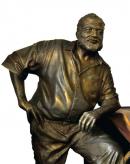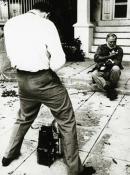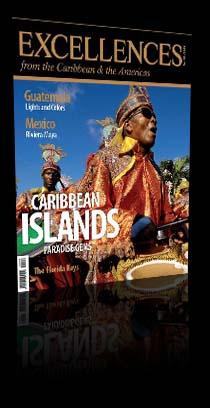Hemingway in Havana
Ernest Hemingway sPent the last 22 years of his life in this city. When he settled down in Finca Vigia, a 30-minute drive from the Cuban capital’s downtown area, he was just about to finish For Whom the Bells Toll. When the author left the estate for good, he’d already basked in the limelight and had even won his well-deserved Nobel Prize. He left behind his then portable Royal, his dogs’ graves, some fifty cats and the 9,000 books he treasured all his life and that many years later made Garcia Marquez exclaim, “Such a rare library this man had!”.
Hemingway arrived in Cuba in early April, 1928. Together with Pauline Pfeiffer –his second wife– he swung by Cuba on his way to Key West where he’d finish Farewell to Arms. He came back in 1932 as a marlin angler in Cuban waters. Came back again a year later and wrote his first chronicles on Cuba. Since then, he never ever broke away from this “long, beautiful and ill-fated island,” as he referred to Cuba in The Green African Hills. The Old Man and the Sea (1952) is by and far Hemingway’s Cuban novel. Part of the plot in Islands in the Stream (1970) takes place in Cuba. In some of his short stories and in many of his journalistic articles, he also referred to the island. The setting of Having and Not Having (1937) is mostly Cuban. He once said about Cuba: “I love this country and I feel like home. And wherever a man feels like home, apart from the place he was born in, that’s the place he was destined to.” Down Obispo Street In the 1930s, Hemingway was a suspiciously resident tourist who used to spend the months of May, June and July in Cuba –the time of the marlin. His first Havana refuge was the Ambos Mundos Hotel on Obispo Street, very near the seaport. The unnumbered guestroom on the fifth floor where he stayed on countless occasions remains intact. At five o’clock after a fishing day, Hemingway used to lock himself up in that room, send for his meal and sit down to write. He used to do the writing by hand and on the bed only to type the manuscripts later on with barely a few corrections in the process. During his well-known interview with George Plimpton in 1958, he recalled: “Ambos Mundos in Havana was a good place to work.” Thanks to his “Marlin Fishing Close to El Morro” chronicle that put him back in the journalism trade after remaining aloof from it for over a decade, now people know some of the habits that marked that famous Ambos Mundos guest. He used to sleep with his feet pointing to the east, so the sun could force him out of bed shortly after its rise. Then, from the window, he used to scan the surroundings: the Cathedral, the port entrance, Casablanca, the building roofs. The Cuban flag fluttering at El Morro could tell him where the wind was blowing to and the choppy sea could help him find out if the trade winds had arrived earlier. Then, conditions were right for marlin fishing. He then used to rush under the shower, put on an old pair of kaki trousers, any shirt he could lay his hands on, a pair of dry moccasins and go down for breakfast –a glass of Vichy water, another glass of cold milk and a slice of bread– before hopping on his boat. Sometimes wearing shorts, sneakers, no socks and a light shirt on, he could be seen walking down Obispo Street. In Islands in the Stream he evoked the smells wafting in the air in that particular area: flour stashed in sacks and flour powder, package boxes that had been recently opened, toasted coffee –“a sensation much stronger than a morning drink,” he once said– and the delicious smell of tobacco… At the Ambos Mundos, the writer was in his elements, perhaps for being perched on a bustling area so close to the seaport where he used to dock his boat. But Martha Gelhorn –his third wife- that anonymous and depersonalized room, coupled with the lack of privacy caused by the visits of her husband’s friends, became too nagging. She was the one who found Finca Vigia. On the onset, Hemingway disliked the place: it was too far from El Floridita. You Live on this Island A good chunk of Islands in the Stream unfolds in this Havana bar. Through the pages of this novel, the reader sees a sauntering character called Liliana the Honest. In real life, her true name was Leopoldina, a brown prostitute who used to “make a living” at El Floridita and who became the writer’s greatest love of all. He remembered her in Islands in the Stream like this: “Her smile was beautiful, her dark eyes son wonderful, plus her splendid black hair… Her face was terse like olive-hued marble –if that kind of marble ever existed- with a light pinkish shade.” La Terraza, a seafood restaurants in the fishermen town of Cojimar, was just another of Hemingway’s favorite hangouts. At El Floridita people still cherish the place where the author used to sit –the first stool to the left of the counter. The same happens at La Terraza with his table, the one on the left corner next to the window. “It’s so nice to be here,” says the main character of Islands in the Stream as he refers to La Terraza. And in that same novel, he describes a daiquiri with its precise flavor and color as “a drink of shallow waters.” In 1949, he explained in a chronicle the reasons behind his long stay in Cuba. He spoke, of course, the of Gulf Stream where “you can find the best and largest catch I’ve ever seen in my life,” of the 18 mango species that grew in his property, of the breeding of roosters and their fights… and he added almost in a breath: “You live on this island (…) because in the morning breeze you can work better and more comfortably than anywhere else.” It was there where he wrapped up For Whom the Bells Toll and where he wrote Through the River and Among the Trees, The Old Man and the Sea, Paris Was a Party and Islands in the Stream, as well as an unfinished novel entitled The Eden Garden, plus plenty of articles and chronicles for periodicals, including a feature report entitled A Bloody Summer about the tug-of-war between bullfighters Antonio Ordoñez and Luis Miguel Dominguin he’d watched in Spain the year before and that, according to his biographers, he had a hard time with before putting an end to it. “I always had good luck while writing in Cuba…” he wrote in a letter. And shortly after he learned he’d won the Nobel Prize, he said in an interview: “This is a prize that belongs to Cuba, because my work was both thought up and written in Cuba, with my people from Cojimar where I’m a citizen. Through all the translations, this adopted homeland where I have my books and my home is always present.” In a chronicle penned in 1936, Hemingway narrated in less than 200 words the story that led him to The Old Man and the Sea a few years later. All researchers agree he was inspired in a Cojimar fisherman named Anselmo Hernandez, though the idea that many other local fishermen chipped in elements to his character cannot be ruled out. The novel’s anecdote is well known. Its sense is quite evident. Hemingway put the right words in the mouth of Santiago, the main character: “Man is not made for defeat. A man can be destroyed, but not defeated.” The novel’s setting is the sea and the old man’s fight against the shark that eventually snatched his catch; man’s struggle for life. “I tried to build a real old man, a real youngster, a real sea, a real fish and real sharks. But if I built them well and real enough, that could mean a lot of things. When you write well and sincerely about something, later on that something means a lot of other things.” And going immodestly straight to the point, he said that The Old Man and the Sea is as if I would have finally given expression to what I was after all of my life.” In his last years, he used to write on his feet, over a fur of lesser kudu because it made him “think more clearly.” He used to wake up early in the morning and could only stop writing when he was absolutely sure of what would happen afterwards. Achieving 500 “clean” words was satisfactory to him and he never typed directly the hardest passages, although he did so with the dialogues. According to Garcia Marquez, Finca Vigia the only truly steady home the author had in his lifetime. Mary Welsh –his fourth and last wife- tidied up the estate and the novelist’s life as much as she possibly could. Since he often grumbled about how bugging visitors used to be, Mary ordered the construction of a three-story tower next to the house. The top floor would be saved as Hemingway’s working room. He went up one day and stayed there for fifteen minutes, a span of time in which he tried to no avail to write a single phase. He came down and never again used that floor to do his writing. He said later one day that he couldn’t stand the solitude. Hara-kiri with a Rifle “Look how I’m going to kill myself,” he told his friend in Finca Vigia. He used to put the butt of his Mannlicher Schoenauer 265 rifle on the floor and prop the barrel on the top of his mouth. The he used to pull the trigger with one of his toes. A hoarse click could be heard as he beamed: “This is the rifle hara-kiri technique.” Following his death, Hemingway’s will was read in Havana. Among the dispositions contained in it, his property of Finca Vigia would go to the Cuban State. The old writer, so reluctant to receive writers in his house, wanted his home to become the meeting ground of young intellectuals and artists, as well as a center for botanical research. Fidel Castro, who admired Hemingway and met him personally during one of the marlin fishing tournaments the author used to organize, proposed the house to be turned into a museum, a suggestion accepted by the novelist’s widower. But more than a museum, Finca Vigia continued to be Hemingway’s home. It looks empty, yet full of life. It seems as if his owner wasn’t dead, but temporarily absent and ready to show up at anytime from El Floridita or one of his hunting trips. He’d then put his carbine somewhere around the house and skimmed through the mail. Anyway, right on a table at the estate there’s a rubber stamp that reads: “I don’t write letters.” He’d have a drink –“a good scotch is very nice, one of the nicest things in life”- and sit next to his portable Royal to keep pegging away at that rare and ambitious novel he left unfinished.































































































































